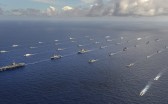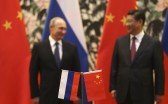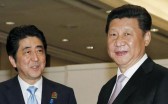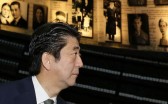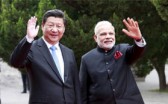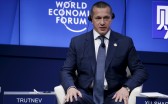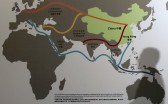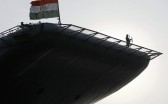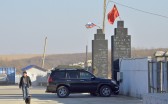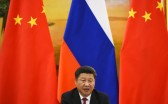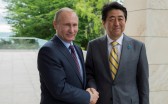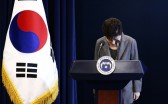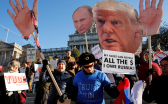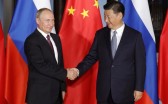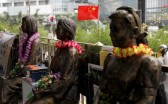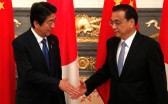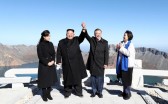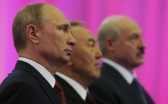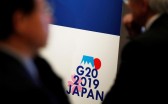The argument for a China-Russia-DPRK triangle in Northeast Asia hinges on the idea that these three countries are willing to coordinate their actions on the international stage, adopt similar positions on key regional questions, and develop trilateral cooperation in economic or military spheres. I argue below that at present, there is little evidence of such a triangle. This analysis looks, in turn, at Russian-North Korean and at Sino-North Korean relations.
It is true that relations between Russia and North Korea are better today than at any time since the 1980s. Year 2015 was declared their official “year of friendship.” There has been a flurry of government delegations scurrying each way and discussion of increasingly ambitious economic and investment projects. This intensification of Russo-North Korean contacts has not gone unnoticed in global media, in large part because of the deep crisis in Moscow’s relations with the West. Superficially, it would appear that President Vladimir Putin is trying to compensate for estrangement in the West by “cozying up” (The Guardian’s formulation) to Russia’s former allies in the East, through rebuilding an upgraded version of the long-defunct “camp” under Russian leadership, comprised of nations like North Korea. Given the buzz over the new “Cold War” between Russia and the West and the noticeable improvement in Sino-Russian relations, such a deja vu interpretation has a natural appeal. However, the similarity is in the form rather than the substance. Russia is neither willing nor able to sustain the sort of relationship the Soviet Union had with North Korea in either political or in economic terms. North Korea occupies a relatively insignificant place in Russia’s broader regional strategy, and it is unlikely to move up on the order of priorities any time soon.
There are both political and economic limitations in this relationship. For all the recent talk about close ties, bilateral trade between North Korea and Russia remains not only insignificant but also highly volatile, a result of the low baseline and variation in year-on-year contracts. To give a few examples from recent years, the volume of Russian-North Korean trade in 2014 was USD 92.2 million, a bit below USD 112.7 million reached in 2013. One should see this statistic against the broader background: between 2006 and 2014, bilateral trade fluctuated between USD 210.5 million (in 2006) and a dismal USD 49.4 million (in 2009). Current figures—at the time of the supposed renaissance of the Moscow-Pyongyang relationship—are in fact less than half of what they were in 2006. For comparison, Russia’s trade with North Korea was a minuscule 0.34 percent of its 2014 trade with South Korea (USD 27.2 billion) and 0.29 percent of that with Japan (USD 30.8 billion), both of which ostensibly belong to the “other” triangle. What these figures indicate is that for all the dramatic political posturing, Russia and North Korea have very little traction in economic terms. If there is an economic triangle in Northeast Asia that Russia is a part of, it certainly does not include North Korea.
It is, nevertheless, interesting how keen Moscow has been to bolster economic ties with the DPRK. This eagerness stems from a broader notion that, with the West allegedly in decline, Russia’s economic future lies in developing trade with emerging markets. In order to create the right conditions for the expected trade and investment bonanza with the DPRK, Putin agreedi in 2014 to write off 90 percent of the USD 10.96 billion Soviet-era North Korean debt, with the remaining 10 percent being reinvested into North Korea. The idea here was that, as in the case with other Soviet-era debts, Russia was not going to see any money in any case, while getting the issue out of the way would clear the road to its participation in various development projects in North Korea. Another new measure was to allow bilateral tradeii in rubles (first transactions were made in October 2014, and by April it had reached the equivalentiii of USD 62.9 million). Russia has also advertised the opening of the rail link between the village of Khasan south of Vladivostok and the North Korean port of Rajin. A pier was reconstructed in Rajin by Russian Railroads, and it is now being used for off-loadingiv Russian coal, planned to be 1.5 million tons by the end of this year. Although for now these strides have failed to make a visible dent in the trade balance, the indefatigable Russian Minister for the Development of the Far East Aleksandr Galushka has already predictedv that the turnover between Russia and North Korea will reach USD 1 billion in 2020.
The question here is not that these predictions are a priori unrealizable but in the assumptions that underpin thinking of people like Galushka. The central idea here is not that North Korea’s sudden economic prosperity will drive demand for Russian imports, or that, say, in place of the half-a-million dollars’ worth of North Korean jackets imported in 2014, Russia will import $5 million worth in 2020: these kinds of dramatic changes do not happen overnight. Instead, Russian predictions of a trade bonanza with the DPRK rest on the idea of North Korea, in effect, serving as a corridor for the transit of Russian electricity and natural resources into South Korea, and the transit of South Korean goods the other way. These plans for “transit corridors” have a long history, and they form the foundation for most long-term thinking in Moscow with regard to economic engagement with North Korea. But what these plans require is: a) peace and stability on the Korean peninsula, and b) inter-Korean dialogue, which would make it possible for corridors to be laid through the world’s most militarized border. By contrast, escalation of inter-Korean tensions makes all such projects impossible.
If in economic terms, South Korea is by far more important to Russia than its impoverished northern cousin, perhaps North Korea matters for other reasons. There are two possibilities here, both addressed in Gilbert Rozman’s analysis. The first is strategic. As Russia’s relations with the West sour, Putin will want to project influence in North Korea, whether in the bilateral context or in the context of trilateral cooperation with China. However, this is nothing new. Since the end of WWII, there was only one time when Russia sought to deliberately distance itself from North Korea: this was in the early 1990s, and it was done primarily for ideological reasons at the height of Moscow’s short-lived turn to the West and against the background of rapidly deepening engagement with South Korea. Russia’s return to North Korea—by this I mean political return because in economic terms it never really returned—occurred very shortly after Putin’s rise to power, when in July 2000 he became the first Russian (or Soviet) leader to visit Pyongyang and meet with the North Korean leadership. Putin’s calculus was fairly simple: rapprochement with North Korea bolstered Russia’s regional leverage, which Moscow was quick to deploy in subsequent years in the context of the Six Party Talks.
Apart from using North Korea to assume greater importance in Northeast Asia than it would perhaps otherwise enjoy, Russia is guided by the imperative of preventing Korean unification. This is of course not an official policy, but the continued existence of North Korea is important in the sense of preventing the United States from expanding its security commitments in the region. A reunified, US-allied, Korea is by default seen as undesirable in Moscow, now more than ever. Thus, Russia’s regional policies are designed to prolong the life expectancy of the North Korean regime. These policies are understood and appreciated in Beijing for a very similar set of reasons. Inasmuch as Beijing, Moscow, and Pyongyang are all basically interested in the survival of North Korea, one could speak of a triangle of convenience. But this triangle has to coexist uneasily with the shared interest of all regional players (minus North Korea) in keeping the Korean problem from boiling over. Here, Pyongyang’s position sharply diverges from that of its two friends. North Korea sees its nuclear deterrent as the only viable guarantee of regime survival. Beijing and Moscow, however, continue to insist on North Korea’s denuclearization. At the same time, they are not willing to pressure Pyongyang to disarm, reasonably fearing political backlash. The difficult balance between cautious support for, and careful censure of North Korea, can only be sustained for as long as Kim Jong-un refrains from doing something overly provocative. Any serious Pyongyang-engineered crisis on the Korean Peninsula will expose the fundamental contradictions in Russian and Chinese foreign policies towards Korea, blowing the fragile Sino-Russian-North Korean “triangle” out of the water.
Another important reason why Rozman argues in favor of a new “triangle” in Northeast Asia is the alignment of the “national identities” of China and Russia in relation to the North Korean question. As the argument goes, Putin and Xi Jinping share deep concern over the prospects of Western subversion (let’s call it the “color revolution complex”), and their support for Pyongyang is just a function of the fear that, in the event of North Korea’s untimely collapse, their countries too would come under mounting pressure of political liberalization. This rationale is important, and it is easily observable. For instance, Beijing’s rhetoric in connection with the recent protests in Hong Kong suggestedvi serious concern about the prospects of American “subversion.” In the meantime, the Russians, on the heels of the Ukrainian crisis, have spared no effort to persuadevii Asian audiences that “the epidemic of color revolutions” was the main danger for the Asia Pacific. Such comments have mostly raised skeptical brows across the region, but there is no denying that the obsession with US-led democratic conspiracy very much reflects the mindsets of Russian (and to a lesser extent Chinese) policy makers. The North Koreans clearly appreciate this, and have especially tried to capitalize on Moscow’s anti-Western sentiments. As the head of the DPRK Supreme People’s Assembly Choe Tae Bok, who recently visited Moscow, toldviii his Russian counterpart Sergei Naryshkin, “In recent years, the Russian leadership actively defends its strategic interests against illegitimate policy of pressure, economic sanctions from the United States and the West. We highly regard and fully support these steps.”
But a closer look reveals that shared anti-Western sentiments do not really suffice for a triangle based on national identities of China, Russia, and North Korea. The situation here is, in some respects, much more complicated than during the Cold War, when Moscow and Beijing, in spite of their mutual disagreements and, later, open hostility, nevertheless continued to support Pyongyang for ideological reasons. The notion of “proletarian internationalism” that committed Moscow and Beijing to revolutionary causes worldwide is most patently absent from the foreign policies of either country at the present time. Both are instead guided exclusively by considerations of a particular interpretation of national interests, and this interpretation is never a question of black-and-white assignments of labels, as in ‘you hate America, therefore you are our friend,’ but of a cost-and-benefit analysis, subject to pragmatic alteration if changing circumstances so require. This is the reason why someone like Naryshkin, recently a host of a high-profile DPRK delegation, was only weeks earlier in Seoul with assurances that Russia sees South Korea as its “priority and highly promising partner” in the Asia Pacific. This is the reason why, for all of Russia’s recent engagement with China, Putin recently called Japan a “strategic partner”ix and has made it clear that he is willing to negotiate with Tokyo, even on such a thorny problem as the ownership of the Southern Kurile Islands. There is, in other words, more to Russia’s foreign policy in Northeast Asia than meets the eye. What is clear is that Moscow remains opposed to polarization of Asia into contending blocs.
With China, things are equally complex. Beijing remains North Korea’s major sponsor. China’s trade turnoverxi with Pyongyang is nearly 75 times that of Russia’s, and China has invested billions of dollars into the country’s mining sector. Yet, going by economic indicators alone, China’s ties with other regional players are incomparably more important than those with North Korea. Unsurprisingly, China’s three most important foreign trade partners are actually the proverbial triangle of the United States, Japan, and South Korea. There is also now a free trade pactxii between Beijing and Seoul, which could potentially open the way to a triangular free trade area involving China, South Korea, and Japan.
However, leaving the economic angle aside, China does maintain political support for North Korea. The question of national identities has already been broached. I would argue that Beijing’s support does not suggest that it approves of North Korea’s Stalinist economic practices and its atrocious human rights record. In fact, for years the Chinese leadership has carefully urged North Korea to reform, and recently there has been even something of a cooling in the political relationship between the two, with frustration mounting in Beijing over Kim Jong-un’s erratic foreign policy and domestic purges. Strategic concerns are, of course, also important. No less than Russia, China has no desire to see the US military presence potentially extend all the way to the Yalu River. There is also another factor: North Korea remains a part of the legitimacy discourse of the Chinese Communist Party. Collapse of the ostensibly Communist regime in the DPRK would raise uncomfortable questions about China’s own trajectory. Even if these questions would not be as sharp or as painful as those posed in 1989, from the CCP’s perspective it would be best to avoid them altogether, engineering instead North Korea’s gradual transition towards Chinese-style state capitalism.
Any discussion of a Sino-Russian-North Korean triangle must take into account the general trajectory of Chinese foreign policy. Arguably, such a triangle would be completely out of sync with Beijing’s global priorities. These priorities are well known. China has put increasing emphasis on the outward projection of economic might via the “Silk Road Economic Belt” and the “Maritime Silk Road,” two of Xi Jinping’s most important strategic initiatives. Recently, the Chinese have tried to ease Russia’s concerns with their increased assertiveness on the international stage, in particular by offering to coordinate Silk Road plans in Central Asia with Putin’s own regional policies. North Korea, by contrast, hardly ever features in any of these initiatives, its failure to secure admissionxiii to the China-led Asian Infrastructure Investment Bank (AIIB) being a case in point. It is fair to say that whereas North Korea does have a certain reserved place in China’s foreign policy, this is not a place of any great importance. Could it perhaps acquire some importance in the context of possible polarization of Asia into pro-US and pro-China “blocs”? In my opinion, this is unlikely, primarily because such polarization is not, in fact, in the cards. In spite of frictions with its Asian neighbors, China’s overall foreign policy agenda has been inclusive rather than exclusive, open rather than closed, and flexible rather than rigid. Chinese policy makers see their country’s emergence to global power as a process of agglomeration of multiple geometrical arrangements, of which the Sino-Russian-North Korean triangle is not nearly the most important part.
i. http://www.rbc.ru/rbcfreenews/20140505165101.shtml.
ii. http://minvostokrazvitia.ru/press-center/news_minvostok/?ELEMENT_ID=2370.
iii. http://vestiprim.ru/2015/04/26/k-aprelyu-obem-raschetov-v-rublyah-mezhdu-kndr-i-rf-dostig-35-mlrd-galushka.html.
iv. http://vestiprim.ru/2015/04/26/k-aprelyu-obem-raschetov-v-rublyah-mezhdu-kndr-i-rf-dostig-35-mlrd-galushka.html.
v. http://ria.ru/economy/20150427/1061116591.html.
vi. http://www.scmp.com/news/hong-kong/article/1670363/chinas-leaders-fear-subversion-hong-kong-professor-lau-siu-kai?page=all.
vii. Anatoly Antonov, “SHANGRI-LA DIALOGUE 2015” (speech at 14th Asia Security Summit, Singapore, May 30, 2015), http://eng.mil.ru/en/mpc/news/more.htm?id=12037863@egNews.
viii. http://onekorea.ru/2015/06/23/sergej-naryshkin-vstretilsya-s-predsedatelem-verxovnogo-narodnogo-sobraniya-kndr-coj-txe-bokom/.
ix. http://ria.ru/world/20150519/1065255948.html.
x. http://tass.ru/politika/2058744.
xi. “Production at Kaesong Industrial Complex up in 2015” (Yonhap), North Korean Economy Watch, July 9, 2015, http://www.nkeconwatch.com/category/statistics/trade-statistics/.
xii. Shannon Tiezzi, “It’s Official: China, South Korea Sign Free Trade Agreement”, The Diplomat, June 2, 2015, http://thediplomat.com/2015/06/its-official-china-south-korea-sign-free-trade-agreement/.
xiii. Bradley O. Babson, “Could China’s AIIB Be a Game-Changer for North Korea?” The Diplomat, June 4, 2015, http://thediplomat.com/2015/06/could-chinas-aiib-be-a-game-changer-for-north-korea/.
